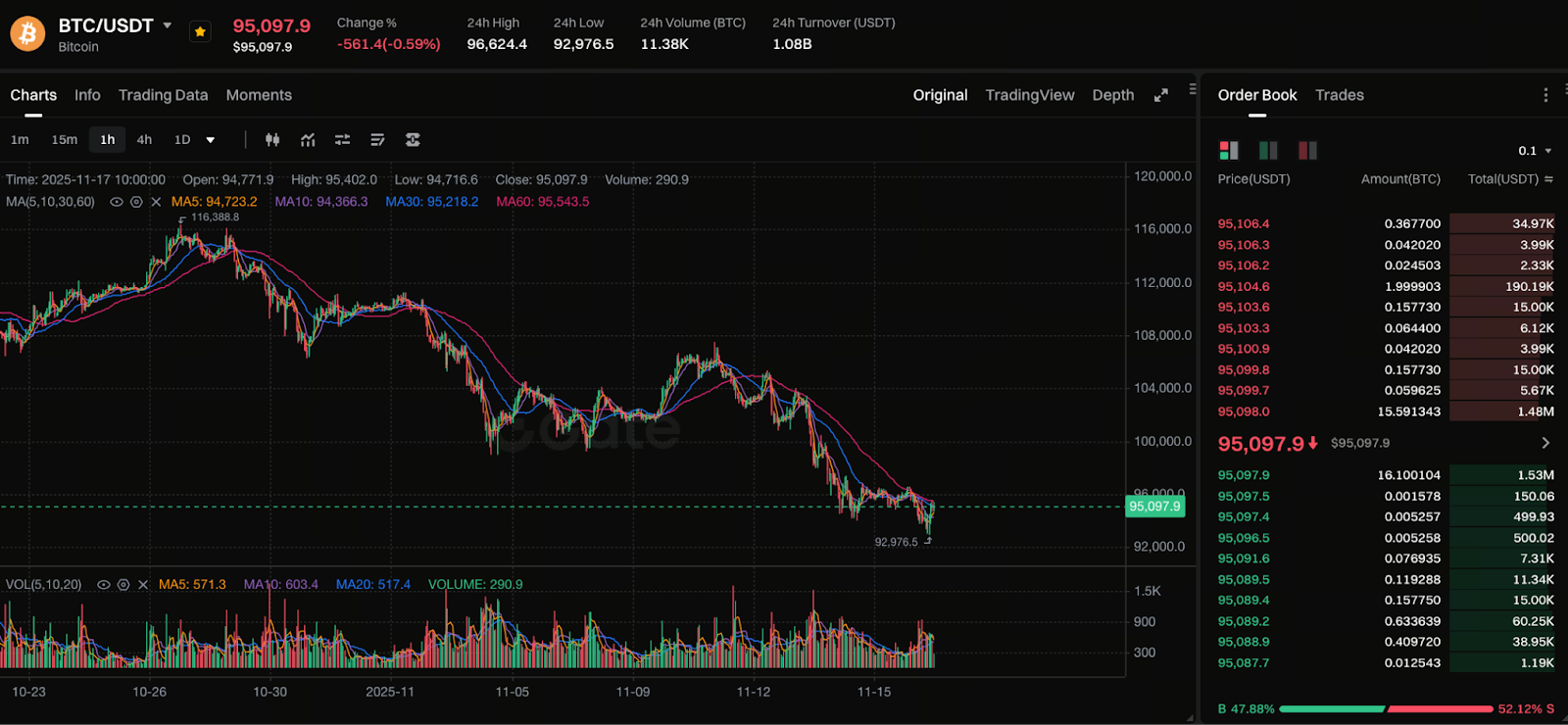Will Bitcoin Return to $120,000? 2025 Bitcoin Price Prediction — In-Depth Analysis
Market Overview and Latest News

View live chart: https://www.gate.com/trade/BTC_USDT
In mid-November 2025, Bitcoin (BTC) experienced significant price swings. Its price briefly dropped to around $93,000—a six-month low—largely in response to hawkish remarks from the Federal Reserve. Chair Jerome Powell indicated that key economic data could be delayed due to a possible government shutdown, introducing uncertainty around a December rate cut. This development dampened risk appetite for crypto assets. Meanwhile, JPMorgan considers Bitcoin currently undervalued, with risk-adjusted returns now appearing more attractive than those of gold after marked deleveraging.
Macroeconomic policy and market sentiment are shaping a critical inflection point for Bitcoin’s price.
Key Drivers Analysis
- Institutional Demand: Institutional investors are entering the Bitcoin market through ETFs. On-chain data shows that major holders (whales) and ETF products are actively accumulating BTC.
- Supply Scarcity: With Bitcoin’s supply capped and institutions continuing to buy, tightening supply further underscores its digital gold status.
- Macroeconomic Factors: Federal Reserve policy, inflation trends, and interest rate expectations remain pivotal. If rate cut expectations return, BTC’s rally could resume. Conversely, a rebound in inflation or rates could heighten volatility.
Multiple Bitcoin Price Prediction Models
Below are several mainstream and emerging forecasting models alongside institutional perspectives:
- On-Chain Indicators & Historical Cycle Models: CoinDesk reports that if Bitcoin’s price holds above $116,000 for several weeks, this would set the stage for a year-end rally toward $160,000–$200,000.
- Polymarket Predictions: Some participants on Polymarket anticipate Bitcoin will not surpass $138,000 in 2025.
- Power-Law Model: Analysts using the power-law model project BTC could see substantial gains—potentially tripling—by the end of 2025.
- Deep Learning / AI Models: Recent academic research indicates that hybrid models (like VMD + LSTM) can deliver reasonably reliable short-term Bitcoin price forecasts.
Other studies using synthetic control methods to analyze Bitcoin halvings suggest that these events may have a sustained positive impact on price.
In summary, conservative forecasts see BTC trading in the $130,000–$140,000 range, while more aggressive projections target $160,000–$200,000 or even higher.
Potential Risk Factors
Although many forecasts remain bullish on Bitcoin, the market also faces the following risks:
- Macroeconomic Policy Uncertainty: Shifts in Fed policy or a resurgence in inflation could weigh heavily on the crypto market.
- Risks related to deleveraging: While some deleveraging has already occurred, large holders taking profits or increasing exchange balances could trigger pullbacks.
- Technical and Security Risks: Hacking, exchange vulnerabilities, and DeFi protocol security issues remain significant concerns.
- Regulatory Pressure: Regulatory approaches to crypto assets differ worldwide, and abrupt policy changes could spark volatility.
Mid- to Long-Term Outlook and Strategic Recommendations
- Mid- to long-term investors: If you see Bitcoin as “digital gold” and are prepared for volatility, this may be a favorable time to accumulate. Consider dollar-cost averaging, maintain long-term holdings and set clear take-profit and stop-loss levels.
- Short-term traders: Focus on key support and resistance levels as well as macroeconomic data, such as Fed meetings and inflation statistics. Use technical analysis to inform your trading decisions.
- Risk Management: Regardless of your strategy, keep allocations moderate and avoid excessive leverage; monitor sentiment indicators, such as the Fear & Greed Index, and adjust your approach as needed.
Related Articles

Pi Coin Transaction Guide: How to Transfer to Gate.io

Flare Crypto Explained: What Is Flare Network and Why It Matters in 2025

How to Use a Crypto Whale Tracker: Top Tool Recommendation for 2025 to Follow Whale Moves

What is N2: An AI-Driven Layer 2 Solution

2025 BTC Price Prediction: BTC Trend Forecast Based on Technical and Macroeconomic Data
